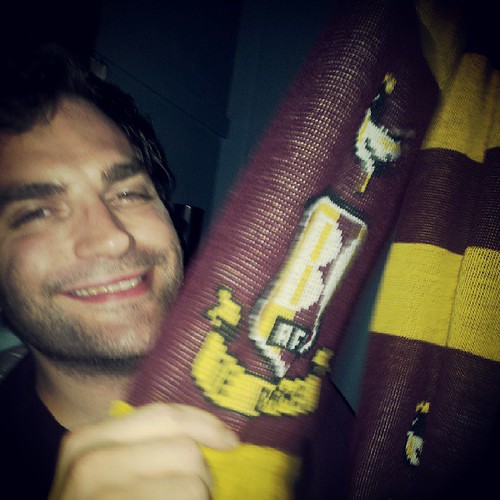Saturday 18th May 2013 (evening)
After delighting in Hobbiton we drove on to Rotorua.
The town is situated on the banks of Lake Rotorua, a volcanic caldera and although the volcano is dormant there is plenty of geothermal activity in the area. The most obvious of which was the incredibly strong smell of sulphur that hit us as we arrived.
We were staying at the Crash Palace Hostel, right in the heart of Rotorua and so we were well placed to get used to the smell (eventually). Our stay at Crash Palace didn’t get off to the smoothest of starts – we were charged for the room despite having already paid via Booking.com. At the same time we were told that because we were staying several nights we could have one night free. Brilliant we thought, everybody loves free nights. Except that we had to make it an additional night on top of our booking. So we rearranged our plans and ended up staying in Rotorua for five nights.
Most importantly however was internet access . The 2012/13 season was remarkable for our beloved football club – one trip to Wembley had already been the stuff of history and when we’d booked our trip we’d done so knowing that we might miss the playoffs. We hadn’t thought it likely, even less so after watching us lose the first leg from our hotel room in Tokyo and had been flying into Auckland when we’d overcome the deficit to book that second trip to Wembley. And so, in the middle of the New Zealand night we watched Bradford City make a winning return to Wembley and promotion to League One.

Sunday 19th May 2013
Despite the sleep limiting contribution of the Bantams’ triumph we were up early enough to visit St Faith’s church, in Ohinemutu on the edge of the lake for a combined Maori/English service. The way in which the two traditions were interwoven was very special and it was fantastic to worship with our brothers and sisters in Christ.
Mind you, because we were there for the service we weren’t able to get our own picture of the stained glass window which shows Jesus walking on the lake:

My cousin John had given me the contact details of a cousin of his, Sheena, so after church we headed to the Rotorua museum where we got to know them over coffee. There’s a strange sensation when you meet distant family for the first time that even though they aren’t blood relatives they’re actually quite familiar and the Watsons still have their Scottish accents despite having lived in New Zealand for over 20 years.
We arranged to join them for dinner that evening and spent the rest of the afternoon on a guided tour of the museum. We’d been told that Rotorua museum was better than Auckland’s and they were right.
The visit was made particularly special by the lady who guided us around. She was an incredible source of knowledge, was so passionate about the shared history of Maori and Pakeha in the Rotorua area and had wonderful anecdotes of the artefacts on display that gave us a truer appreciation of the history of the town.

The museum was divided into two sections: one dealing with the history of the building as Rotorua’s Bath House – where people went for healing in the thermal waters, and the other providing a rich insight into the history of the local Maori iwi. This was significantly better than what we had seen in Auckland – it was well organised and told a coherent story that, as tourists unfamiliar with Maori history, we found much easier to engage with.
As well as the Bath House, Rotorua had previously been popular with tourists wanting to visit the Pink and White Terraces, commonly referred to as the Eighth Wonder of the World. The Terraces were formed by geothermally heated water containing large amounts of silicic acid and sodium chloride from two large geysers. Although they were formed in the same way the 800 metres separating them gave rise to their different colouring – the White Terrace had more exposure to the sun and were therefore bleached more than the Pink Terrace.
The museum had an excellent section on the Terraces and their destruction by the eruption of nearby Mount Tarawera. Shortly after midnight on 10 June 1886, more than 30 increasingly strong earthquakes were felt around Rotorua, at 0200 a larger earthquake was followed by an explosion and by 0230 all three peaks of Mount Tarawera had erupted blasting smoke and ash thousands of metres into the sky. An hour later a pyroclastic surge destroyed several villages within a 6 kilometre radius and with them the Pink and White Terraces.
Although the eruption was heard on the South Island and ash observed 800km away in Christchurch the death toll is estimated to be around 120 (the contemporary toll was 153, exhaustive research has identified 108 individuals and other people put the total even higher).
It is possible to visit the site of Te Wairoa, a model village buried by the volcano but we didn’t. Instead we spent the rest of the afternoon walking around Whakawerawera Forest, the nearby Redwood forest, and finished as the sun had set. This was a fantastic walk – so peaceful – the density of the trees blocking out all noise from the outside world, and walking in the twilight….
We then headed out to the Watson’s as they had invited us round for dinner – we got to meet 5 of their 6 children and their two dogs. They treated us to a lovely home cooked roast dinner with rhubarb crumble – a proper Sunday tea.
You can see all our photos from today on Flickr.
Distance travelled: 20km
Total distance travelled: 21,407km





